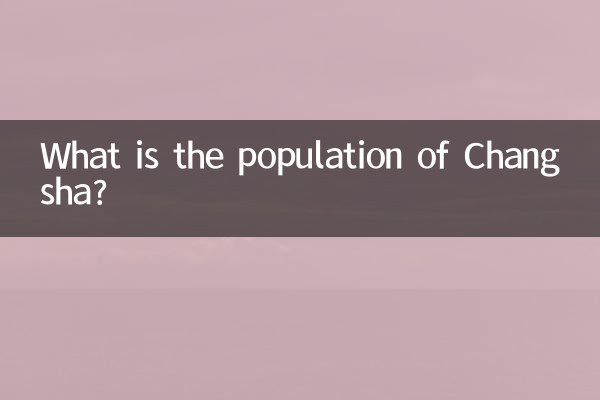What is the population of Changsha? Latest data and urban development analysis
In recent years, Changsha, as the provincial capital of Hunan Province and the national central city, has continued to grow in population and has become an important population gathering place in the central region. This article combines the latest statistical data to analyze Changsha's population status and development trends from multiple dimensions.
1. Total permanent population of Changsha (latest data in 2023)

| Statistical caliber | population | Data source | Statistics time |
|---|---|---|---|
| permanent population | 10.4206 million people | Changsha Municipal Bureau of Statistics | End of 2022 |
| Registered population | 7.2214 million people | Changsha Municipal Public Security Bureau | June 2023 |
| Urban resident population | 5.5464 million people | Ministry of Housing and Urban-Rural Development City Yearbook | 2021 |
2. Analysis of population structure characteristics
| age structure | Proportion | Compare nationally |
|---|---|---|
| 0-14 years old | 14.21% | +0.8% |
| 15-59 years old | 68.33% | +3.2% |
| 60 years and above | 17.46% | -4.0% |
It is worth noting that the proportion of Changsha’s working-age population aged 15-59 is significantly higher than the national average, reflecting the city’s strong demographic attractiveness. In the first half of 2023, the number of newly insured college students in Changsha reached 126,000, continuing to maintain a net inflow of talents.
3. Differences in population distribution among districts and counties
| administrative district | Permanent population (10,000) | Population density (people/square kilometer) |
|---|---|---|
| Yuhua District | 126.8 | 7814 |
| Yuelu District | 152.3 | 4326 |
| Furong District | 64.2 | 12412 |
| Tianxin District | 83.5 | 8923 |
| Kaifu District | 82.7 | 8651 |
Data show that Yuelu District ranks first in total population because it contains the core area of Xiangjiang New District; Furong District, as an old city, has the highest population density of 12,412 people/square kilometer. In recent years, Wangcheng District has the fastest population growth, with a year-on-year growth of 3.2% in 2022.
4. Forecast of population change trends
According to the "Changsha Land and Space Master Plan (2021-2035)", the permanent population is expected to exceed 11 million by 2025 and reach about 12 million in 2035. Key factors supporting continued population growth include:
1.industrial agglomeration effect: Engineering machinery, electronic information and other 100-billion-dollar industrial clusters form employment magnets
2.Talent policy strength: "Changsha Talent Policy 22" has issued a total of more than 5 billion yuan in subsidies
3.Livable city advantages: Awarded as "The Happiest City in China" for 15 consecutive years
4.transportation hub status: The "meter"-shaped high-speed rail network is formed, reaching major urban agglomerations across the country in 3 hours
5. Challenges faced by population development
Although the total population continues to grow, attention needs to be paid to:
- The rate of aging is accelerating, and the proportion of the population over 60 years old has increased by 2.3 percentage points in five years.
- The housing price-to-income ratio reaches 9.2, and new residents are under pressure to settle down.
- The distribution of high-quality educational resources is uneven, with an average annual degree gap of about 12,000
Overall, Changsha is in a critical period of transition from demographic dividend to talent dividend. In the future, it is necessary to transform the advantages of population size into high-quality development momentum through industrial upgrading and public service optimization to help build a national central city.

check the details

check the details